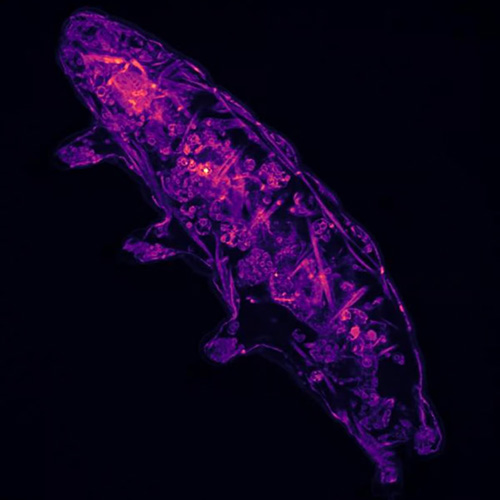Molecular sensor enables water bear hardiness by triggering dormancy
Tardigrades – hardy, microscopic animals commonly known as “water bears” – use a molecular sensor that detects harmful conditions in their environment, telling them when to go dormant and when to resume normal life. A team led by Derrick R. J. Kolling of Marshall University and Leslie M. Hicks of the University of North Carolina at Chapel Hill report these findings in a new study published January 17 in the open-access journal PLoS ONE.

Water bears are famous for their ability to withstand extreme conditions, and can survive freezing, radiation, and environments without oxygen or water. They persist by going dormant and entering a tun state, in which their bodies become dehydrated, their eight legs retract and their metabolism slows to almost undetectable levels. Previously, little was known about what signals water bears to enter and leave this state.
In the new study, researchers exposed water bears to freezing temperatures or high levels of hydrogen peroxide, salt or sugar to trigger dormancy. In response to these harmful conditions, the animals’ cells produced damaging oxygen free radicals. The researchers found that water bears use a molecular sensor—based on the amino acid cysteine—which signals the animals to enter the tun state when it is oxidized by oxygen free radicals. Once conditions improve and the free radicals disappear, the sensor is no longer oxidized, and the water bears emerge from dormancy. When the researchers applied chemicals that block cysteine, the water bears could not detect the free radicals and failed to go dormant.
Altogether, the new results indicate that cysteine is a key sensor for turning dormancy on and off in response to multiple stressors, including freezing temperatures, toxins and concentrated levels of salt or other compounds in the environment. The findings suggest that cysteine oxidation is a vital regulatory mechanism that contributes to water bears’ remarkable hardiness and helps them survive in ever-changing environments.
"Our work reveals that tardigrade survival to stress conditions is dependent on reversible cysteine oxidation, through which reactive oxygen species serve as a sensor to enable tardigrades to respond to external changes," the authors stated.Enjoy reading ASBMB Today?
Become a member to receive the print edition monthly and the digital edition weekly.
Learn moreGet the latest from ASBMB Today
Enter your email address, and we’ll send you a weekly email with recent articles, interviews and more.
Latest in Science
Science highlights or most popular articles

How a gene spurs tooth development
University of Iowa researchers find a clue in a rare genetic disorder’s missing chromosome.

New class of antimicrobials discovered in soil bacteria
Scientists have mined Streptomyces for antibiotics for nearly a century, but the newly identified umbrella toxin escaped notice.

New study finds potential targets at chromosome ends for degenerative disease prevention
UC Santa Cruz inventors of nanopore sequencing hail innovative use of their revolutionary genetic-reading technique.

From the journals: JLR
How lipogenesis works in liver steatosis. Removing protein aggregates from stressed cells. Linking plasma lipid profiles to cardiovascular health. Read about recent papers on these topics.

Small protein plays a big role in viral battles
Nef, an HIV accessory protein, manipulates protein expression in extracellular vesicles, leading to improved understanding of HIV-1 pathogenesis.

Genetics studies have a diversity problem that researchers struggle to fix
Researchers in South Carolina are trying to build a DNA database to better understand how genetics affects health risks. But they’re struggling to recruit enough Black participants.

